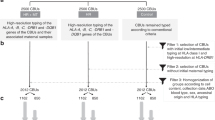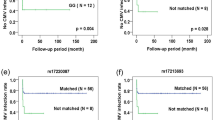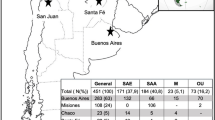Abstract
The success of allogeneic hematopoietic stem cell transplantation depends in part on the accuracy of human leukocyte antigen (HLA) matching between the donor–recipient pair. The higher the number of matching HLA alleles, the smaller the chance that the transplant recipient will develop complications. Umbilical cord blood (UCB) transplantation was noted to result in a remarkably low frequency and severity of graft-versus-host disease (GvHD) and graft rejection compared to that in unrelated bone marrow transplant recipients. At present most banks match UCB donors for respective recipients by HLA-A, -B low-resolution typing and -DRB1 high-resolution typing. We retrospectively conducted high-resolution sequence-based HLA typing on DNA samples available from 65 Chinese UCB-recipient pairs typed previously by using low-resolution sequence-specific oligonucleotide probes and sequence-specific primers, and evaluated the clinical outcome. High-resolution typing revealed imperceptible HLA alleles that were hardly identified in low-resolution typing. Univariate analyses demonstrated no significant correlation between the extents of high-resolution HLA disparity with engraftment, graft failure, acute GvHD, transplant-related mortality and long-term 6-year overall survival. Data from the study suggest that high-resolution typing for HLA-A, -B and -DRB1 contributed no substantial improvement to UCB transplant outcome. Low-resolution typing appears to be amenable to matching UCB-recipient pairs without compromising the quality of transplant.
This is a preview of subscription content, access via your institution
Access options
Subscribe to this journal
Receive 12 print issues and online access
$259.00 per year
only $21.58 per issue
Buy this article
- Purchase on Springer Link
- Instant access to full article PDF
Prices may be subject to local taxes which are calculated during checkout

Similar content being viewed by others
References
Wernet P . The Netcord inventory and use [Netcord web site] October 2006. Available at: https://www.netcord.org/inventory.html. Accessed on February 16, 2007.
Petersdorf EW, Hansen JA, Martin PJ, Woolfrey A, Malkki M, Gooley T et al. Major-histocompatibility-complex class I alleles and antigens in hematopoietic-cell transplantation. N Engl J Med 2001; 345: 1794–1800.
Morishima Y, Sasazuki T, Inoko H, Juji T, Akaza T, Yamamoto K et al. The clinical significance of human leukocyte antigen (HLA) allele compatibility in patients receiving a marrow transplant from serologically HLA-A, HLA-B, and HLA-DR matched unrelated donors. Blood 2002; 99: 4200–4206.
Flomenberg N, Baxter-Lowe LA, Confer D, Fernandez-Vina M, Filipovich A, Horowitz M et al. Impact of HLA class I and class II high-resolution matching on outcomes of unrelated donor bone marrow transplantation: HLA-C mismatching is associated with a strong adverse effect on transplantation outcome. Blood 2004; 104: 1923–1930.
Greinix HT, Fae I, Schneider B, Rosenmayr A, Mitterschiffthaler A, Pelzmann B et al. Impact of HLA class I high-resolution mismatches on chronic graft-versus-host disease and survival of patients given hematopoietic stem cell grafts from unrelated donors. Bone Marrow Transplant 2005; 35: 57–62.
Giebel S, Giorgiani G, Martinetti M, Zecca M, Maccario R, Salvaneschi L et al. Low incidence of severe acute graft-versus-host disease in children given haematopoietic stem cell transplantation from unrelated donors prospectively matched for HLA class I and II alleles with high-resolution molecular typing. Bone Marrow Transplant 2003; 31: 987–993.
Chalandon Y, Tiercy JM, Schanz U, Gungor T, Seger R, Halter J et al. Impact of high-resolution matching in allogeneic unrelated donor stem cell transplantation in Switzerland. Bone Marrow Transplant 2006; 37: 909–916.
Kogler G, Enczmann J, Rocha V, Gluckman E, Wernet P . High-resolution HLA typing by sequencing for HLA-A, -B, -C, -DR, -DQ in 122 unrelated cord blood/patient pair transplants hardly improves long-term clinical outcome. Bone Marrow Transplant 2005; 36: 1033–1041.
Wu JY, Liao C, Xu ZP, Chen JS, Gu SL, Huang YN et al. Banking and transplantation of umbilical cord blood in Guangzhou, China. Cytotherapy 2006; 8: 488–497.
Glucksberg H, Storb R, Fefer A, Buckner CD, Neiman PE, Clift RA et al. Clinical manifestations of graft-versus-host disease in human recipients of marrow from HLA-matched sibling donors. Transplantation 1974; 18: 295–304.
Schoemans H, Theunissen K, Maertens J, Boogaerts M, Verfaillie C, Wagner J . Adult umbilical cord blood transplantation: a comprehensive review. Bone Marrow Transplant 2006; 38: 83–93.
Ottinger HD, Ferencik S, Beelen DW, Lindemann M, Peceny R, Elmaagacli AH et al. Impact of HLA-A, B, C allele mismatches on outcome after unrelated blood stem cell transplantation in whites. Transplantation 2004; 78: 1077–1080.
Wagner JE, Barker JN, DeFor TE, Baker KS, Blazar BR, Eide C et al. Transplantation of unrelated donor umbilical cord blood in 102 patients with malignant and nonmalignant diseases: influence of CD34 cell dose and HLA disparity on treatment-related mortality and survival. Blood 2002; 100: 1611–1618.
Ooi J, Iseki T, Takahashi S, Tomonari A, Nagayama H, Ishii K et al. A clinical comparison of unrelated cord blood transplantation and unrelated bone marrow transplantation for adult patients with acute leukaemia in complete remission. Br J Haematol 2002; 118: 140–143.
Sanz GF, Saavedra S, Planelles D, Senent L, Cervera J, Barragan E et al. Standardized unrelated donor cord blood transplantation in adults with hematologic malignancies. Blood 2001; 98: 2332–2338.
Laughlin MJ, Barker J, Bambach B, Koc ON, Rizzieri DA, Wagner JE et al. Hematopoietic engraftment and survival in adult recipients of umbilical-cord blood from unrelated donors. N Engl J Med 2001; 344: 1815–1822.
Gluckman E, Rocha V, Arcese W, Michel G, Sanz G, Chan KW et al. Eurocord Group. Factors associated with outcomes of unrelated cord blood transplant: guidelines for donor choice. Exp Hematol 2004; 32: 397–407.
La Nasa G, Argiolu F, Giardini C, Pession A, Fagioli F, Caocci G et al. Unrelated bone marrow transplantation for beta-thalassemia patients: the experience of the Italian Bone Marrow Transplant Group. Ann N Y Acad Sci 2005; 1054: 186–195.
Laughlin MJ, Eapen M, Rubinstein P, Wagner JE, Zhang MJ, Champlin RE et al. Outcomes after transplantation of cord blood or bone marrow from unrelated donors in adults with leukemia. N Engl J Med 2004; 351: 2265–2275.
Rocha V, Labopin M, Sanz G, Arcese W, Schwerdtfeger R, Bosi A et al. Transplants of umbilical-cord blood or bone marrow from unrelated donors in adults with acute leukemia. N Engl J Med 2004; 351: 2276–2285.
Michel G, Rocha V, Chevret S, Arcese W, Chan KW, Filipovich A et al. Unrelated cord blood transplantation for childhood acute myeloid leukemia: a Eurocord Group analysis. Blood 2003; 102: 4290–4297.
Krampera M, Tavecchia L, Benedetti F, Nadali G, Pizzolo G . Intracellular cytokine profile of cord blood T-, and NK-cells and monocytes. Haematologica 2000; 85: 675–679.
Szabolcs P, Park KD, Reese M, Marti L, Broadwater G, Kurtzberg J . Coexistent naive phenotype and higher cycling rate of cord blood T cells as compared to adult peripheral blood. Exp Hematol 2003; 31: 708–714.
Miyakoshi S, Yuji K, Kami M, Kusumi E, Kishi Y, Kobayashi K et al. Successful engraftment after reduced-intensity umbilical cord blood transplantation for adult patients with advanced hematological diseases. Clin Cancer Res 2004; 10: 3586–3592.
Barker JN, Weisdorf DJ, DeFor TE, Blazar BR, Miller JS, Wagner JE . Rapid and complete donor chimerism in adult recipients of unrelated donor umbilical cord blood transplantation after reduced-intensity conditioning. Blood 2003; 102: 1915–1919.
Bacigalupo A, Lamparelli T, Bruzzi P, Guidi S, Alessandrino PE, di Bartolomeo P et al. Antithymocyte globulin for graft-versus-host disease prophylaxis in transplants from unrelated donors: 2 randomized studies from Gruppo Italiano Trapianti Midollo Osseo (GITMO). Blood 2001; 98: 2942–2947.
Hawkins BR, Dunbar MM, Liang R, Chiu E, Lie A, Chan TK . Probability of finding a matched donor for bone marrow transplantation in a Chinese population: two year experience of an all-Chinese marrow donor registry. Transplant Proc 1995; 27: 1375–1376.
Acknowledgements
We thank the clinicians of 24 transplant centers in China for performing UCB transplants and providing clinical data of 65 patients in this study, namely; The Second Affiliated Hospital of Sun Yat Sen University, Guangzhou, Guangdong Province (n=18); Anhui Provincial Hospital, Hefei, Anhui Province (n=11); Shanghai Children's Medical Center, Shanghai (n=4); The First Affiliated Hospital of Jinan University, Guangzhou, Guangdong Province (n=4); Guangzhou Maternal and Neonatal Hospital, Guangzhou, Guangdong Province (n=3); Lu Dao Pei Ward, Affiliated Hospital, Peking University, Beijing (n=3); Peking Children's Hospital, Beijing (n=2); Naval General Hospital, Beijing (n=2); Guangdong Provincial People Hospital, Guangzhou, Guangdong Province (n=2); Guangzhou First Municipal People's Hospital, Guangzhou, Guangdong Province (n=2); Affiliated Xijing hospital, The Fourth Military Medical University, Xian, Shanxi Province (1); Affiliated Hospital of Guiyang Medical College, Guiyang, Guizhou Province (n=1); The 12th Municipal People's Hospital, Guangzhou, Guangdong Province (n=1); Haikou People Hospital, Haikou, Hainan Province (n=1); Henan Cancer Hospital, Zhengzhou, Henan Province (n=1); Institute of Hematology, Huazhong University of Science and Technology, Wuhan, Hubei Province (n=1); Military General Hospital, Guangzhou, Guangdong Province (n=1); Nanfang Hospital, Guangzhou, Guangdong Province (n=1); Soochow University Affiliated Children's hospital, Suzhou, Jiangsu Province (n=1); The First People's Hospital of Foshan, Foshan, Guangdong Province (n=1); The Second Guangdong Provincial People's Hospital, Guangzhou, Guangdong Province (n=1); The Third Affiliated Hospital of Sun Yat Sen University, Guangzhou, Guangdong Province (n=1); Tongji Hospital of Tongji Medical College, Wuhan, Hubei Province (n=1) and West China Hospital, Sichuan University, Chengdu, Sichuan Province (n=1).
This work was supported in part by funding of projects #96-Z-64-1 and #2003C34006 of Guangdong Provincial Scientific Technological Committee, the project #99-Z-008-01 of Guangzhou Scientific Technological Committee, Five Ones Project #1996-23 of Guangdong Provincial Health Bureau and the scientific technological project of Guangzhou Health Bureau in 1996, China.
Author information
Authors and Affiliations
Corresponding author
Rights and permissions
About this article
Cite this article
Liao, C., Wu, J., Xu, Z. et al. Indiscernible benefit of high-resolution HLA typing in improving long-term clinical outcome of unrelated umbilical cord blood transplant. Bone Marrow Transplant 40, 201–208 (2007). https://doi.org/10.1038/sj.bmt.1705711
Received:
Revised:
Accepted:
Published:
Issue Date:
DOI: https://doi.org/10.1038/sj.bmt.1705711
Keywords
This article is cited by
-
Inference of high resolution HLA types using genome-wide RNA or DNA sequencing reads
BMC Genomics (2014)
-
Double umbilical cord blood transplantation for children and adolescents
Annals of Hematology (2010)
-
Role of HLA in hematopoietic SCT
Bone Marrow Transplantation (2008)



